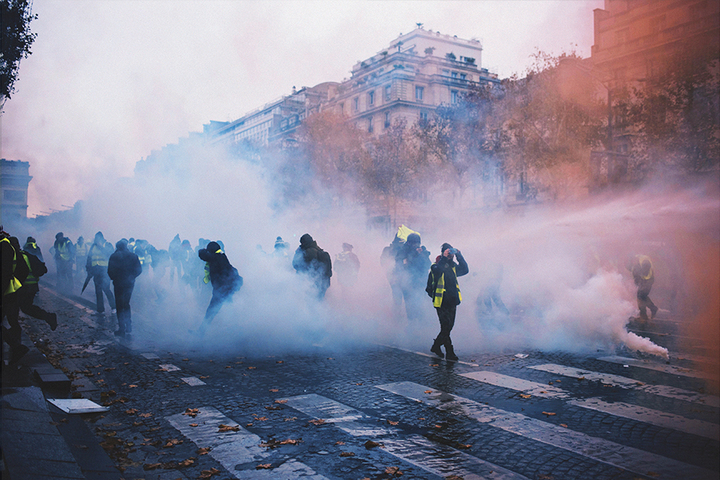For a new era of revolution.
In November last year, hi-vis swarms stormed Paris to loot Givenchy, trash the Arc de Triomphe, and dismantle Emmanuel Macron’s social order. In far-flung provinces all over France, people pulled yellow safety vests out of their trunks and occupied roundabouts. Though the gilets jaunes did show up wearing a familiar shade of yellow, the rumors of our predictive powers are greatly exaggerated. No one could have foretold this movement. The events of the last few months are nothing if not surprising: ordinary people crashing tractors into toll booths while their comrades sprayed high-pressure horse shit on government buildings in Limoges.
Before the gilets jaunes, there seemed to be only one offer on the table: Macron’s agenda to reform France, bringing it closer to the neoliberal austerity experienced in the rest of Europe. Few things seem less likely now.
The movement is not without its contradictions. Not everyone draped in the yellow vest seeks the same kind of liberation as we do. Movement participants improvise an understanding of the rigged game of capitalist society based on ideas that are in the air, among which are the poison gases of anti-Semitism, nationalism, and xenophobia, speaking of a French people made whole again only through an expurgation of foreign elements. These strains of thought are without a doubt present, even if self-identified fascists have often been ejected by the broad movement. This is a feature of mass social struggle that we have to face with sober senses: there are no guarantees that an authentic emancipatory project will triumph over counterrevolutionary impostors.
Yet it is only in moments like these that it becomes possible to imagine the contours of revolution. Mass social struggles like the gilets jaunes provide the context in which large numbers of people openly declare their lack of confidence in the world and embark on a search for new beginnings. That is the lever that moves social reality, opening up possibilities for radical change—in other words, for the sort of change that actually gets at the root of things.
All of a sudden, on a cold winter morning, people come out of their houses and apartments to do something they never would have imagined doing. They camp out on the side of roads in Nantes and talk to their neighbors about overthrowing the government. They march through the streets of Budapest to protest the imposition of forced overtime without pay. They stand on picket lines in the early morning to defend public education in Los Angeles. They call in sick to work at LaGuardia Airport, ending a month-long government shutdown. We call these struggles because disrupting the normal flow of society is no easy task.

While setting such struggles in motion takes courage and a lot of work, they always arrive as a surprise. Activists exert great effort on campaigns to promote awareness or incite social change, and yet these campaigns rarely lead to wider waves of mass action. When breakthroughs do happen, the people who get involved, the slogans under which they organize, and the tactics they use are often the least expected. This was true of the occupation of Zuccotti Park in September 2011 and true, also, of the shutdown of the 288 freeway in Houston in July 2013 (after Trayvon Martin’s murderer was acquitted). It was true of the NoDAPL camp at Standing Rock in August 2016, and the wildcat strike of West Virginian teachers in February 2018. These actions resonated across the country, setting in motion a cascade of events and opening new political horizons, precisely because no one saw them coming.
Just as the Arab Spring presaged the emergence of Occupy in the United States, the gilets jaunes may foretell the emergence of a similar movement here. This is not to say that we expect people to don yellow safety vests, trash the Washington Monument, and then retreat to desolate highway underpasses across rural America, though we’d be there with them if they did. Repetitions are rarely so literal. To do what the gilets jaunes have done—to break out suddenly, magnetize huge numbers of people, catalyze collective rage, and renew our sense of hope—such a movement would need to look very different.
How does one expect the unexpected? What does a revolutionary bug-out bag contain, and can you order one from Commune, along with one of our yellow hoodies? Not yet! In the meantime, however, the articles we’ve assembled, in this issue and on our website, about the gilets jaunes and a host of other topics, testify to a new common sense about how to relate to struggles when they do emerge, how to assist in their development. All too often, people on the radical left stand aside from popular movements, waiting to confirm that their politics will pass an exhausting purity test. Or else they do show up, but act separately from the rest of the movement, doing what they would be doing otherwise, but dressed in the clothing of the hour.
The articles that follow propose something different. They suggest that the first thing to do is to get involved, immerse yourself in the struggle. What is important above all is to be there: at the camp, the blockade, the picket line, the assembly, the occupied factory. They ask you to go as a participant rather than observer, breaking out of your friend group, talking to strangers, and risking yourself in an encounter with the unexpected. Such liaisons can be frightening, but also exciting, empowering, transforming. (The articles also remind us that the dangers are real, the questions at stake matters of life and death. Be ready to protect yourself.)
It is when we really immerse ourselves in events as they unfold, when we really go all in, that we can make them our own, fighting for what and who we have come to care about, kicking out the cops and inviting in the refugees. Not to take control of the movement and steer it in some predetermined direction, but rather to contribute to its own unfolding dynamic. There is no one simple trick for transforming a social movement into a revolutionary upsurge. Anyone who says otherwise is selling snake oil.
The truth is that all struggles carry within them their own limits, as their strengths, the source of their explosive growth, become weaknesses. If there’s any hope, it derives from the way new struggles relate to and build off of previous ones. Within such moments, our writers remind us, all that one can do is push the struggle to its limits, onward to breakthrough or failure. That means making the struggle as disruptive as possible, keeping open the tiny window in which reality might actually change. To be as disruptive as possible means escalating mass actions, but it also means making sure people have warm food to eat and hot coffee to drink. It means keeping alive the excitement and hope of the movement as well as its anger, so the struggle does not become consumed by self-destructive militancy. It means, as much as possible, spreading the struggle to new geographical locations and new sectors of the population. It means paying attention, listening for the new watchwords that define a time and its possibilities: “que se vayan todos,” “the people want the regime to fall,” “occupy everything,” “black lives matter,” “water is life,” or “tout le monde déteste la police.”
Just think about how such slogans have spread since the onset of the 2008 global economic crisis ten years ago, flung around the globe by new tactics and new organizational forms. Back then, the only possibilities on the table were neoliberalism and neoconservatism, austerity and militarization. The terrible consequences of those political projects are with us today and continue to isolate us from one another. But who thought back then that we would see what we’ve seen in the last ten years: strikes, occupations, riots, blockades. Wildcatting teachers and airport shutdowns. The next ten years won’t be pretty, but we at least have some basis for some hope.





